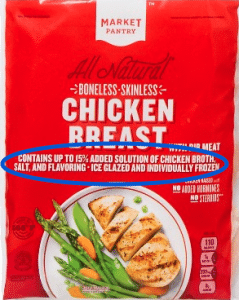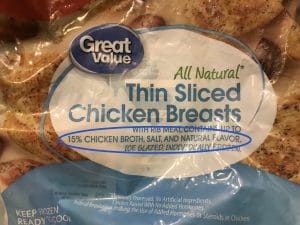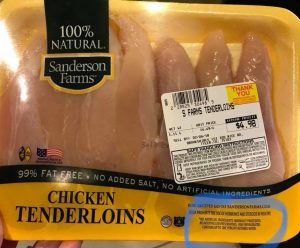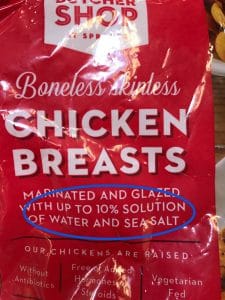Chicken. It’s what’s for dinner. Oh wait. Wrong saying. (If you have no idea what I am talking about, you might not have been around the 90’s). Well, that’s ok because chicken now often outranks beef anyway! Chicken is one of the most popular meats, mainly due to its low cost and relatively low fat content. Americans consume about 28 billion pounds of chicken every year (more than any other meat).
One of the most common questions we get on our 5 Dinners 1 Hour Facebook group is, “Why does chicken often let out so much excess liquid?”. It is natural for meat to let out some liquid (hence the reason for juicy meat), but we are going to take a look into why your chicken might be swimming in a puddle of water (ever heard of chicken plumping?). I am also going to give you a few general tips at the end on cooking with chicken.
Chicken “Plumping” and the Watery Mess it Creates
Do you ever wonder why your chicken is sitting in a big puddle of liquid after it thaws? Most meat companies now inject chicken with a salt water mixture in order to (they say) help keep the chicken moist and add more flavor. This practice is sometimes referred to as chicken “plumping”.
The problem with that is that the extra liquid often ends up in your dish after it thaws, leaving you with less chicken than what you paid for. There can be anywhere between 1% to over 20% of extra solution added to chicken. The cheaper brands tend to add more of that solution, making it not as great as a deal as you think. I have compared some different brands of chicken to show you which brands have some of the most and least added liquid.
The Target Market Pantry brand of frozen chicken breasts contains 15% of chicken broth, salt, and “flavoring”, while the fresh Market Pantry chicken breasts contains only 1-3%.
Walmart’s Great Value brand of frozen chicken breasts also contains 15% of chicken broth, salt, and “natural flavorings”.
Foster Farms brand chicken has the lowest added liquid I have seen: the package says it may contain up to 1% of retained water.
The Sprout’s brand Butcher Shop contains 10% “solution of water and sea salt”.
The list, of course, could go on and on comparing brands, but this gives you an idea of what to look for.
If you bought that chicken for $2.50 a pound, you would be paying .37 a pound of that for the saltwater that was added to it. You might be paying a cheaper price per pound, but if you take into account the percentage you are paying for water, you are not getting as good of a deal as it seems.
If your chicken dishes are constantly ending up with a lot of extra liquid, start looking at the label to see the percentage of water that is being added. With all that being said chicken plumping, do keep in mind that all types of meat will produce some extra liquid as it is cooked. Finding a brand of chicken with a lower percentage of added liquid, though, will help cut back on the amount of excess liquid and help you pay less money per pound of actual chicken.
Other Tips for Cooking with Chicken
Since we are on the subject of chicken, I will conclude with some general tips on cooking with chicken.
- Getting tender chicken: The size of chicken breast nowadays are often just huge! This not only increases cooking time (a lot!), but also creates a tougher finished product. When you get your chicken home from the store, filet each breast, cutting it in half width-wise. Hold the chicken under the palm of your hand and cut it in half horizontally. This will make it cook much faster. I also like to tenderize it by pounding it out a little with a meat hammer. This will not only make the chicken turn out more tender, but it’s also a great way to take out some pent up aggression!
- Although they can be a little more expensive, I often use chicken tenderloins instead of chicken breasts. Tenderloins come from the underside of chicken breasts. Since they are much smaller, they not only thaw quicker, but they also cook much faster. As long as you do not overcook them, they almost always come out super moist and tender!
- When grilling chicken, make sure the chicken is patted dry before putting the seasoning on and before putting it on the grill. This will help the chicken to sear better and keep it from sitting in extra liquid as it cooks. Also, make sure the grill or grill pan is nice and hot before adding the chicken (or any other meat for that matter).
- For recipes that call for cooked chicken, keep some extra pulled rotisserie chicken in your freezer. Next time you get a rotisserie chicken, buy two and put the extra in a freezer bag. You will be grateful for the extra time it will save you next time you need it!
Try our Chicken Cordon Bleu
Hopefully, this information about chicken plumping and tips on cooking with chicken will help your 5 Dinners in 1 Hour dishes turn out even better! As an added bonus, I am sharing one of my favorite 5 Dinners 1 Hour chicken recipes with you: Inside Out Chicken Cordon Bleu! It has all the flavor of chicken cordon bleu, but is so much easier to put together and quick to cook! You can find many other great recipes by subscribing to one of our meal prep plans here.
| Servings: 4-6 |
Ingredients
- 6 boneless chicken breasts
- 1 t dried parsley
- 6 sliced Swiss cheese
- 2 oz cream cheese
- 6 deli sliced ham
- 1/2 C bread crumbs
- 6 C salad greens
- 16 oz green beans
Instructions
- Place chicken in 9 x 13 baking dish sprayed with non stick spray.
- Spread cream cheese over chicken.
- Sprinkle with parsley.
- Top with ham, Swiss then bread crumbs.
- Cover with foil.
- Bake covered in 400 degree oven for 30 minutes or until chicken is no longer pink.
- Uncover and bake 5 minutes to crisp bread crumbs.
- Cook green beans according to package directions.
- Serve with green salad.
Ingredients
Prep
On Cooking Day
|
Instructions
To Assemble
To Cook
|






 Cheesy Bacon Egg Keto Muffins
Cheesy Bacon Egg Keto Muffins